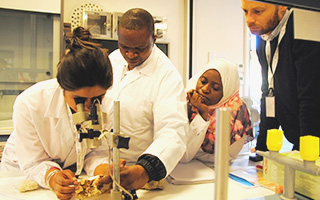ICCROM has actively engaged in research activities since its creation by promoting or coordinating research in different fields and involving ICCROM staff and external specialists from partner institutions.
In the first decades following ICCROM's foundation, these initiatives were generally undertaken in collaboration with the specialized conservation committees of the International Council of Museums (ICOM), the International Institute for Conservation of Historic and Artistic Works (IIC) and the International Council on Monuments and Sites (ICOMOS), or with relevant national conservation institutes such as the Istituto Superiore per la Conservazione ed il Restauro (ISCR) and the Royal Institute for Cultural Heritage (KIK-IRPA).
The main subjects of study were the control of humidity in historic buildings (especially during the salvage campaigns in Florence and Venice), conservation of stone, conservation of structures in unbaked bricks in Iraq, mural paintings and polychrome sculpture. Another major research project contributed to the UNESCO campaign for Nubian monuments. In addition, ICCROM also prepared Guidelines for a National Policy for Conservation Laboratories (1981), which outlines the types of laboratories that could be useful for different conservation purposes, defining the field of application of the laboratory and the required staff, premises and equipment. Research aimed at improving methods for the conservation of endangered materials and also focused on the analysis of salts, plasters, mortars, cement and grouts for the structural stabilization of old masonry and rock structures.
ICCROM set up its in-house laboratory in the late 1960s, installing and operating new equipment for training purposes and collecting materials for didactic experiments. The laboratory aimed to support documentation, promote research, and offer advice and recommendations, especially related to training and emergency services. ICCROM Archives keep precious materials related to scientific analysis and research work carried out by ICCROM's Laboratory, including the heritage material samples collected and donated to ICCROM by the famed conservators Paolo Mora and Laura Sbordoni Mora, as well as the chemist Giorgio Torraca and conservator Rodolfo Luján-Lunsford.

